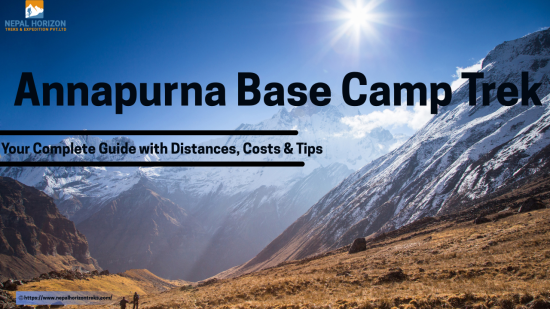Everest Base Camp Trek Details, Cost & Preparation
10th October 2025
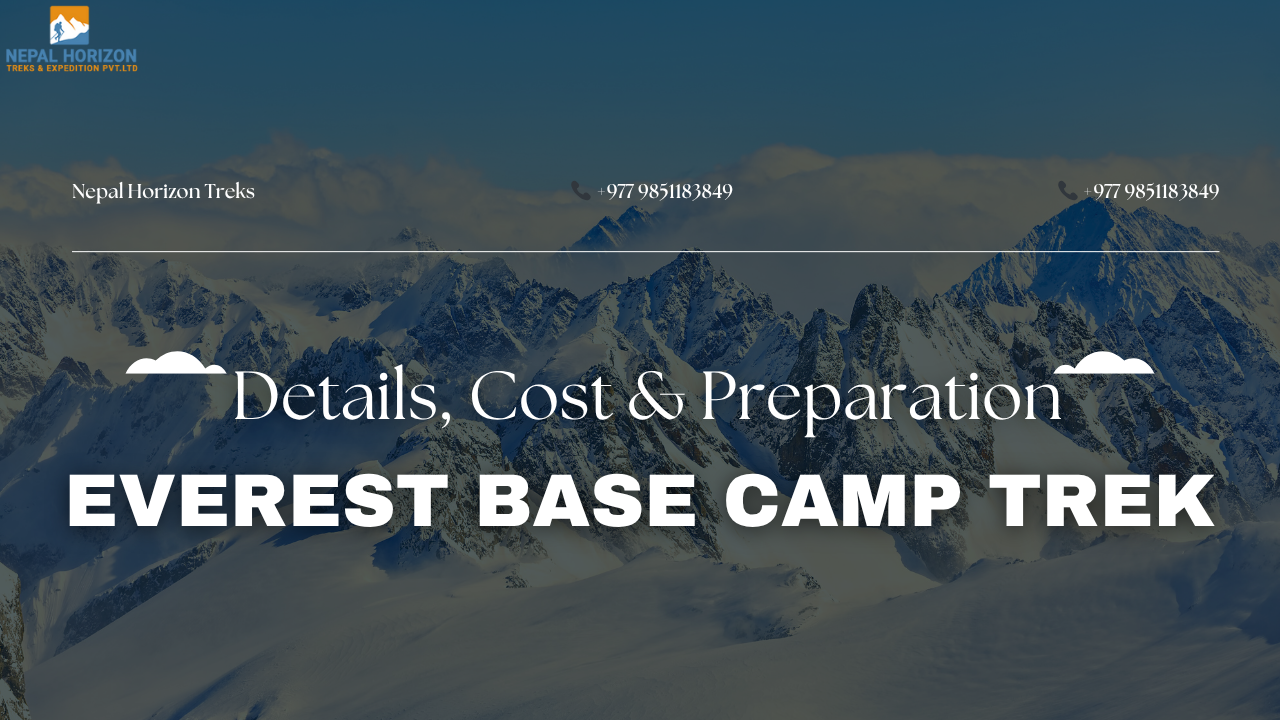
Introduction
There are adventures, and then there’s the Everest Base Camp journey — a path to the foot of the world’s highest mountain, Mt. Everest (8,848.86 m). For adventurers worldwide, this iconic route is more than just a mountain walk; it’s a once-in-a-lifetime experience filled with breathtaking views, Sherpa culture, and the thrill of walking in the footsteps of legendary mountaineers.
If you’ve ever dreamed of standing face-to-face with Everest, witnessing the golden sunrise over snow-capped peaks, and immersing yourself in Himalayan life — this is your ultimate adventure.
In this Everest Base Camp guide, we’ll cover everything you need to know, including when is the best time to visit Everest Base Camp, itinerary details, accommodation, safety, costs, and insider tips — so you can plan your perfect trip with confidence.
Overview of the Everest Base Camp Experience
The Everest Base Camp (EBC) journey is one of the most famous mountain adventures in the world. The trail winds through the heart of the Khumbu region, taking you from the bustling town of Lukla (2,860 m) to the legendary base of Mount Everest (5,364 m).
Along the way, you’ll pass through charming Sherpa villages, suspension bridges draped with prayer flags, ancient monasteries, and panoramic viewpoints of Himalayan giants like Lhotse, Ama Dablam, Nuptse, and of course, Everest itself.
- Region: Khumbu (Everest) Region, Nepal
- Starting Point: Lukla (Flight from Kathmandu or Ramechhap)
- Ending Point: Lukla
- Max Elevation: Kala Patthar (5,545 m)
- Duration: 12–16 days
- Difficulty: Moderate to challenging
When Is the Best Time to Visit Everest Base Camp?
One of the most asked questions is — When is the best time to visit Everest Base Camp?
The ideal seasons are spring (March–May) and autumn (September–November).
Spring Season (March to May)
Spring is a beautiful time to go. The weather is stable, skies are clear, and the rhododendron forests are in full bloom. It’s also the time when Everest expeditions begin, so you’ll meet climbers preparing for their summit attempt.
Pros: Warm daytime temperatures, colorful trails, great mountain visibility.
Cons: Slightly crowded, especially in April and May.
Autumn Season (September to November)
Autumn offers crisp air, stunning visibility, and comfortable weather. After the monsoon clears the dust, the Himalayan peaks shine brilliantly.
Pros: Perfect weather, ideal for photography, fewer flight delays.
Cons: Popular season — advance booking recommended.
Other Seasons:
- Winter (December–February): Cold but peaceful. Great for solitude seekers.
- Monsoon (June–August): Lush greenery but slippery paths and flight cancellations are common.
Nepal Horizon Trek offers customized EBC packages for every season — choose the one that fits your adventure style!
Everest Base Camp Duration and Itinerary
The Everest Base Camp itinerary usually takes around 12–16 days, depending on your pace and acclimatization needs. Here’s a classic 14-day EBC plan:
Day 1: Fly to Lukla (2,860 m) & Walk to Phakding (2,610 m)
A thrilling flight from Kathmandu to Lukla kicks off your adventure. From Lukla, walk for about 3–4 hours to reach Phakding, a riverside village.
Day 2: Walk from Phakding to Namche Bazaar (3,440 m)
Cross suspension bridges over the Dudh Koshi River and enter Sagarmatha National Park. The climb to Namche Bazaar is steep but rewarding.
Day 3: Acclimatization at Namche Bazaar
Explore the Sherpa capital, visit the museum, and hike to the Everest View Hotel for your first glimpse of Everest.
Day 4: Walk to Tengboche (3,860 m)
Pass through pine forests and reach Tengboche, home to the region’s most famous monastery with stunning views of Ama Dablam.
Day 5: Walk to Dingboche (4,410 m)
The path gradually ascends through rhododendron forests and yak pastures. Overnight at Dingboche.
Day 6: Acclimatization at Dingboche
Take a short hike to Nangkartshang Peak for spectacular views of Makalu and Ama Dablam.
Day 7: Continue to Lobuche (4,910 m)
You’ll pass through the memorials of climbers who lost their lives on Everest before reaching Lobuche.
Day 8: Reach Gorak Shep (5,164 m) & Everest Base Camp (5,364 m)
This is the highlight of your adventure! Arrive at EBC, where climbers prepare for summit attempts. Celebrate your achievement and rest at Gorak Shep.
Day 9: Hike to Kala Patthar (5,545 m) & Descend to Pheriche (4,240 m)
Climb early morning to Kala Patthar for a sunrise view of Everest, then descend to Pheriche.
Day 10–12: Return via Namche to Lukla
Retrace your steps and enjoy your final days in the mountains.
Day 13–14: Fly back to Kathmandu
Celebrate your successful Everest Base Camp experience!
Route and Major Stops
The classic path follows this sequence:
Lukla → Phakding → Namche Bazaar → Tengboche → Dingboche → Lobuche → Gorak Shep → Everest Base Camp → Kala Patthar → Return via same route.
Each stop offers something unique:
- Lukla: Gateway to Everest, with one of the world’s most thrilling airports.
- Namche Bazaar: A lively Sherpa town with cafes, shops, and Wi-Fi.
- Tengboche: Famous monastery with panoramic mountain views.
- Dingboche: Ideal acclimatization spot surrounded by towering peaks.
- Gorak Shep & Kala Patthar: Ultimate viewpoints of Everest.
Accommodation and Meals
Accommodation mainly consists of tea houses—basic lodges run by local Sherpa families. Rooms are simple but cozy, with twin beds and blankets.
Meals are surprisingly diverse, ranging from Nepali dal bhat to pasta, soups, and pancakes. Hot tea, coffee, and snacks are available throughout the journey.
Tip: Always drink boiled or filtered water, and carry reusable bottles to reduce plastic waste.
Difficulty and Fitness Requirements
The adventure is moderate to challenging, depending on your fitness level. You don’t need mountaineering experience, but you should be in good physical condition.
- Daily walking: 5–7 hours
- Trail type: Steep ascents/descents, rocky paths
- Altitude: Up to 5,545 m (risk of AMS)
Training tips:
- Start cardio workouts (jogging, cycling, hiking) 6–8 weeks before.
- Practice walking with a loaded backpack.
- Stay hydrated and take acclimatization days seriously.
Cultural Experiences with the Sherpa Community
The Khumbu region is home to the Sherpa people, known for their mountaineering skills and warm hospitality. During your adventure, you’ll visit monasteries, prayer walls, and chortens, gaining insight into Tibetan Buddhism and Sherpa traditions.
Don’t miss the Tengboche Monastery, where you can join morning prayers surrounded by Himalayan silence.
Safety, Permits, and Guidelines
Essential Permits:
- Sagarmatha National Park Entry Permit – NPR 3,000
- Khumbu Pasang Lhamu Rural Municipality Permit – NPR 2,000
Both can be arranged by Nepal Horizon Trek or purchased en route.
Safety Tips:
- Ascend slowly to avoid altitude sickness.
- Carry Diamox (after consulting your doctor).
- Stay hydrated and avoid alcohol at high altitude.
- Always go with a licensed guide and porter for support and safety.
Gear and Packing Tips
Packing smartly is essential for comfort and safety.
Must-have gear includes:
- Warm jacket, thermal layers, and trekking pants
- Waterproof boots and socks
- Sleeping bag (rated -10°C or lower)
- Trekking poles
- Sunglasses, sunscreen, and gloves
- First-aid kit and personal medicines
- Power bank and water purification tablets
Nepal Horizon Trek provides a detailed packing checklist for clients before every trip.
Cost and Travel Recommendations
The Everest Base Camp cost depends on the package and services included. On average, the 14-day journey costs between USD 1,200 – USD 1,800, which covers permits, accommodation, meals, guide, porter, and flights.
Tips to Save Money:
- Travel in small groups.
- Bring refillable water bottles and snacks.
- Book early to get flight discounts.
Nepal Horizon Trek offers customized, affordable, and safe packages with professional guides and flexible itineraries.
Conclusion
The Everest Base Camp adventure isn’t just about reaching 5,364 meters — it’s about the journey. The landscapes, the people, the stories, and the sheer sense of achievement will stay with you forever.
From the thrill of the Lukla flight to the silence of the Himalayas, every step brings you closer to your dream of standing before Mount Everest.
Book your Everest Base Camp trek with Nepal Horizon Treks and experience the adventure of a lifetime!
Whether you’re a first-time explorer or a seasoned adventurer, our expert team ensures your journey is safe, memorable, and life-changing.
FAQs About Everest Base Camp
- When is the best time to visit Everest Base Camp?
The best time is spring (March–May) and autumn (September–November) for clear skies, stable weather, and great visibility. - How long does the journey take?
Typically 12–16 days, depending on your itinerary and acclimatization schedule. - Is the Everest Base Camp route difficult?
It’s a moderate-to-challenging experience, suitable for fit beginners with basic training. - Do I need a guide and permits?
Yes, a licensed guide is mandatory in Nepal. You’ll need the Sagarmatha National Park and Khumbu Rural Municipality permits. - What is the highest point?
Kala Patthar (5,545 m) offers the best close-up view of Mount Everest. - What should I pack?
Warm layers, trekking boots, a sleeping bag, and basic gear. Nepal Horizon Trek provides a complete packing guide.
For the best Everest Base Camp trek experience in Nepal,
Contact Nepal Horizon Treks — your local adventure partner for safe, guided, and unforgettable journeys.
📞 +977 9851183849 | 📧 info@nepalhorizontreks.com
📍 Thamel, Chhetrapati, Kathmandu, Nepal
Recent From Blogs

10th October 2025

7th October 2025

27th September 2025
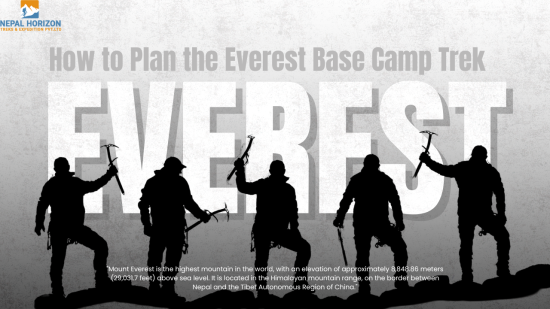
25th September 2025

22nd September 2025
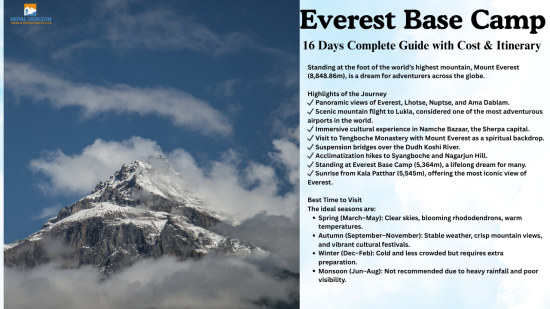
20th September 2025

17th September 2025
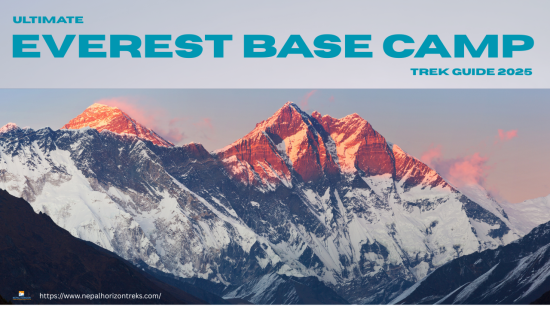
15th September 2025
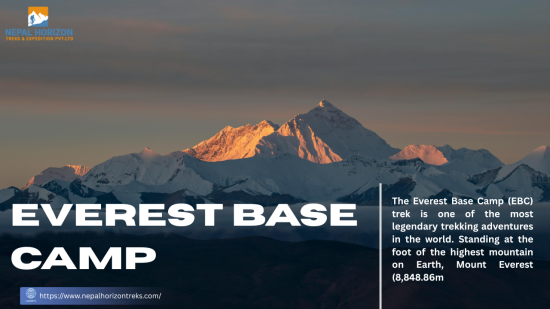
13th September 2025
